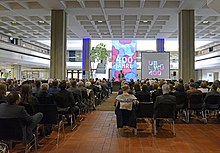Universitätsbibliothek Würzburg

The Universitätsbibliothek Würzburg is the central library of the
History
In 1619, the prince bishop Johann Gottfried von Aschhausen founded the Bibliotheca Academica Godefridiana. Until 1981, it was housed in the Renaissance building of the Old University at Domerschulstraße 16.
In the 17th and 18th centuries, the book holdings grew through the purchase of private book collections, e.g. of the canons of Augsburg and Eichstätt
The fire destroyed 80% of the stock. The restoration of the library rooms in Domerschulgasse[3] was completed in 1957. In 1981, the new building (architect: Alexander von Branca) was occupied on the extension site Am Hubland. The building also housed the Institut für Hochschulkunde until June 2014.
Among the important librarians of the Würzburg University Library are Peter von Richarz and Anton Ruland. In 2019, the University Library celebrated its 400th anniversary with a varied and extensive anniversary programme.[4] One of the highlights of the anniversary year was the exhibition "Ivory & Eternity", in which over 70 top pieces from the special collections were presented in a unique compilation.
Library system and holdings
The analogue holdings of the UB comprise about 3.6 million media, including about 8000 current periodicals. In addition to the printed holdings, users have access to an extensive electronic offering (
UB Würzburg in numbers (2019)


| Total print media: | 3,547,423 |
| Total digital stocks: | 214,589 |
| New acquisitions (print + digital): | 64,523 |
| Users: | 23,643 |
| Opening days/week: | 7 |
| Information
(Central Library and partial libraries): |
37,501 |
| Tours and courses: | 620 |
| 1 central library: | |
| Visits: | 884,710 |
| Borrow: | 567,326 |
| workplaces: | 850 |
| 16 sub-libraries: | |
| Visits: | 1,117,244 |
| workplaces: | 1,789 |
Service
The University Library offers introductory courses for special target groups, e.g. for students, pupils and teachers, as well as events aimed at a wider audience. These include guided tours of the Special Collections Department under a specific theme. For its intensive and exemplary cooperation with schools, the University Library has repeatedly received the Bavarian seal of approval Libraries – Partners of Schools. In addition, numerous information literacy courses are offered, which are integrated into the curricula of almost all courses of study at the University of Würzburg. Throughout the opening hours of the central library, library users can obtain advice by telephone or in person at the information desk. An information management system is available for enquiries, requests, acquisition suggestions and criticism (Ask the UB, based on
Special collections
The special collections of the UB are managed by two departments, each of which has a special area of responsibility:
The Department of Manuscripts and Early Printed Books catalogues and administers the valuable old and special holdings of the University Library. The collection, which has been growing for more than 400 years, experienced its greatest growth during the years of secularisation, when numerous books and manuscripts from the monasteries and foundations in and around Würzburg reached the University Library. Today, the holdings looked after by the department include not only the approx. 2300 manuscripts and approx. 3000 incunabula but also numerous prints from the years before 1801, as well as papyri, autographs, estates, original
The Franconian Department Regional Studies is in charge of the most extensive collection of Franconian literature or literature about Franconia, its culture and history in a scientific library. Since 1962, the Lower Franconian Bibliography has also been compiled here as a regional bibliography for the Bavarian administrative district Lower Franconia, today as part of the Bayerische Bibliographie. Spatially seen the main focus of the collection is Lower Franconia, but literature about Middle and Upper Franconia as well as Henneberger Land, Hohenlohe, Württembergisch and Badisches Franken is also collected.[6]
Further reading
- Hans-Günter Schmidt: 400 Jahre Universitätsbibliothek Würzburg. Bibliothek für Universität, Stadt und Region seit 1619. In Bibliotheksforum Bayern 13 (2019), pp. 9–15
- Eva Pleticha-Geuder: Neubau-Träume. Die Planungen für einen Neubau der Universitätsbibliothek Würzburg von 1800–1945. In Leonhard-Frank-Gesellschaft (ed.), Festschrift der Leonhard-Frank-Gesellschaft zum 80. Geburtstag von Werner Dettelbacher, Würzburg: Echter, 2006, pp. 79–91
- Sigrid von der Gönna; Eva Pleticha-Geuder: Würzburg 1. Universitätsbibliothek. In Handbuch der historischen Buchbestände in Deutschland. Edited by Bernhard Fabian. Vol. 13. Hildesheim u. a.: Olms-Weidmann 1997, pp. 88–125
- Gottfried Mälzer: Aus der Schatzkammer der Universitätsbibliothek Würzburg. Ausstellung anlässlich des Kolloquiums der Internationalen Bibliophilengesellschaft [vom 15. September bis zum 14. Oktober 1990 in der Universitätsbibliothek]. Universitätsbibliothek Würzburg, Würzburg 1990 (German and Englisch).
- Karl Südekum: Die Universitätsbibliothek auf dem Weg in das nächste Jahrtausend. Würzburg – heute 67 (1999), pp. 6–7.
- Jahresberichte der Universitätsbibliothek Würzburg
- Bibliotheksforum Bayern, Jahrgang 10 (1982), issue 2: Universitätsbibliothek Würzburg.
References
- ISBN 3-923959-14-1, here p. 6 f.
- ^ Gottfried Mälzer: Würzburg as a city of books. In Karl H. Pressler (ed.): From the antiquarian bookshop. Vol. 8, 1990 (Börsenblatt for the German Book Trade – Frankfurt Edition.) No. 70, 31 August 1990), p. A 317 – A 329, here: p. A 326 and A 329.
- ^ Julius-Maximilians-University of Würzburg under Georg Keller, senior state librarian and deputy director of the University Library: Lecture directory for the summer semester 1948. Universitätsdruckerei H. Stürtz, Würzburg 1948, p. 16.
- ^ "400 Years University Library of Würzburg" (in German). Retrieved 20 November 2020.
- ^ Gottfried Mälzer: Würzburg as a city of books, written in France in the 6th century. In Karl H. Pressler (ed.): From the antiquarian bookshop. Vol. 8, 1990 (Börsenblatt for the German Book Trade – Frankfurt Edition.) No. 70, 31 August 1990), p. A 317 – A 329, here p. A 321 f.
- ^ "Virtuelle Bibliothek Würzburg". vb.uni-wuerzburg.de. Retrieved 2023-02-05.
External links
- Literature by and about Universitätsbibliothek Würzburg in the German National Library catalogue
- Official website
- Universitätsbibliothek Würzburg in the Deutsche Digitale Bibliothek (German Digital Library)
- Franconica Online
